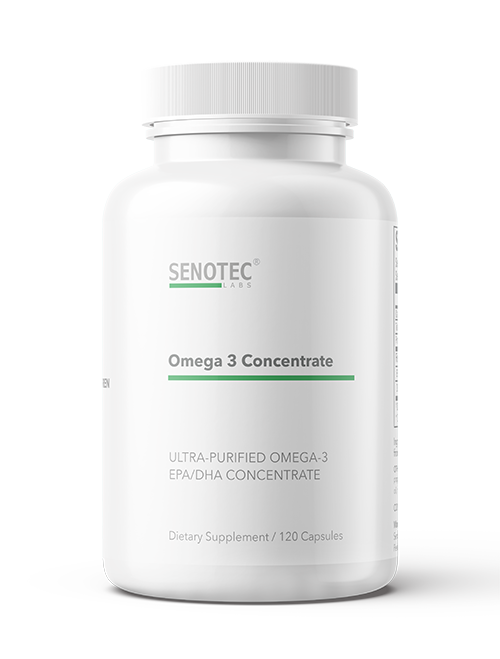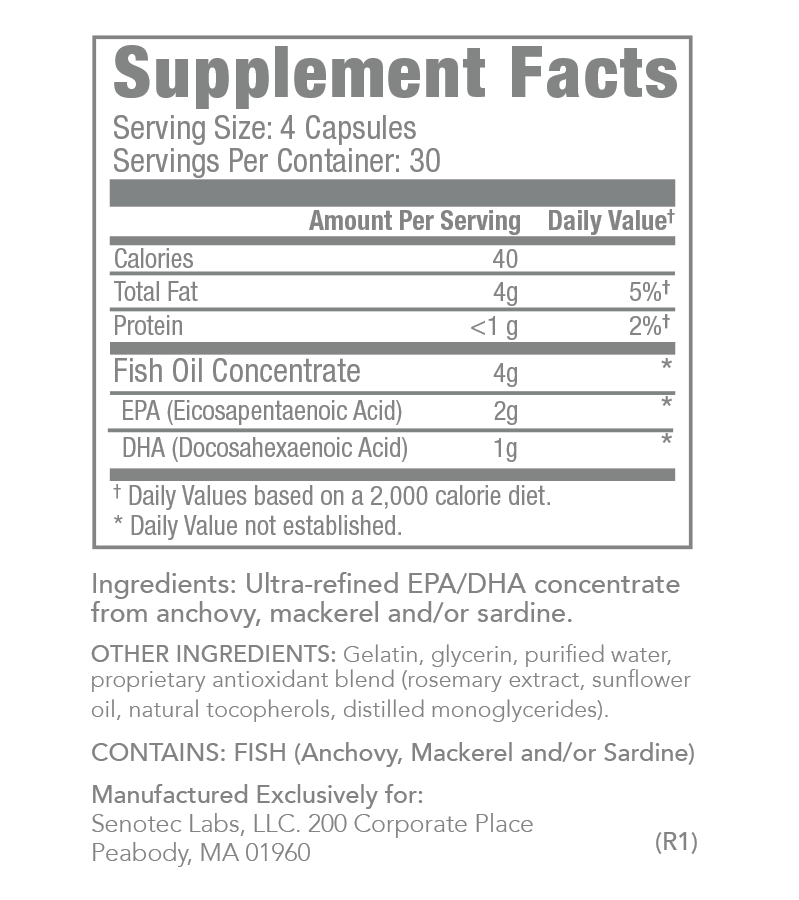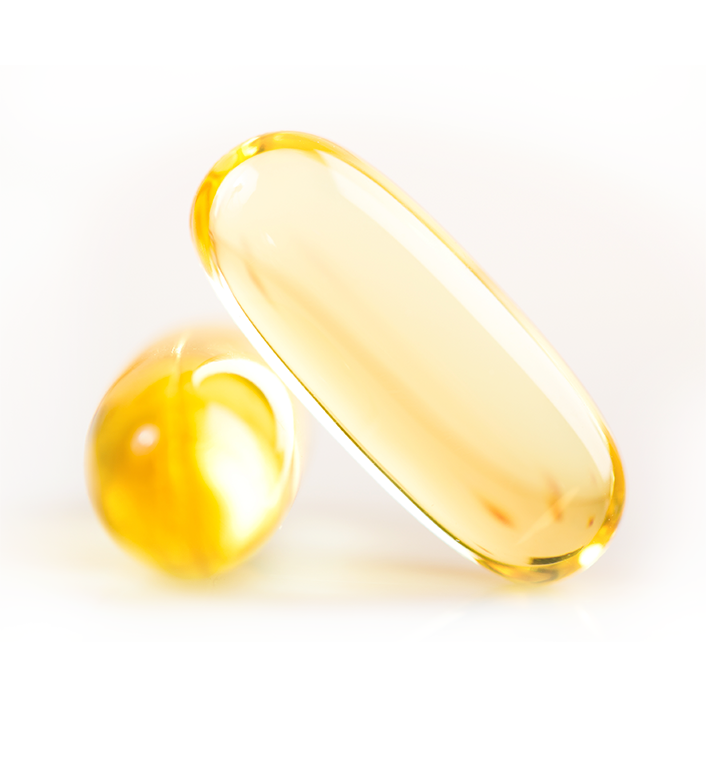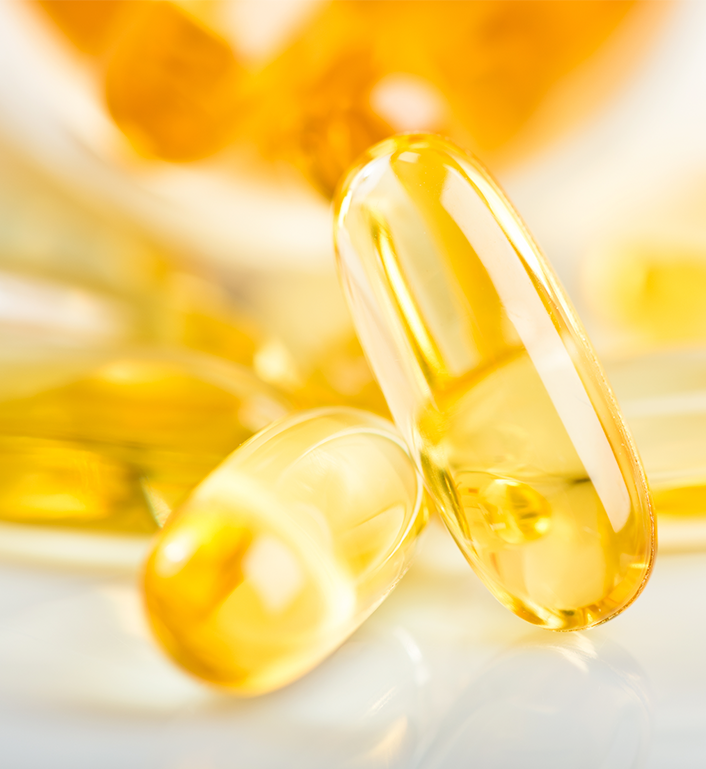Dr. Sears’ OmegaRx 2 Fish Oil – 120 Capsules
Contact your physician for pricing.
OmegaRx®2 Sets the Standard in Purity, Potency and Freshness
OmegaRx 2 consists of purified oil from wild anchovies and sardines caught off the coast of Chile. With state-of-the-art manufacturing coupled with the science of Dr. Sears, OmegaRx 2 has become the leader in purity, potency, and freshness. OmegaRx 2 is a rich source of EPA and DHA, supplying one of the highest concentrations of omega-3s (75%) available in the consumer marketplace. This ensures you reap the greatest benefits from your omega-3 fish oil.
OmegaRx 2 Supports the Following Health Benefits
- Brain Health
- Heart Health
- Behavior and Mood
- Athletic Performance
- Vision
- Pre/Postnatal Health
Why OmegaRx 2 Should Be Your Choice for Omega-3 Fish Oil
- Potency: Supplies 500mg of EPA and 250mg of DHA per gram (1 capsule) of fish oil. Each serving of OmegaRx 2 (4 capsules or 1 tsp) supplies 3000mg of EPA and DHA.
- Freshness: Our proprietary antioxidant blend provides greater stability to protect OmegaRx 2 from oxidation. The TOTOX value, one measure of “freshness”, of each batch of OmegaRx 2 shows we have some of the freshest oil on the market to date.
- The Ideal 2:1 Ratio of EPA to DHA: Based on the research of Dr. Sears, OmegaRx 2 supplies the ideal ratio of EPA and DHA which has been clinically shown to cover the widest range of health benefits.
- Transparency: We think it’s important that you know the purity, potency, and freshness of OmegaRx 2 which is why we post the values of every lot of OmegaRx 2 post-production on our website.
- Sustainability: Our suppliers have a long-term commitment to protecting the seas and currently hold a Friend of the Seas Certification (a non-profit dedicated to the conservation of the marine habitat)
- Leadership: Dr. Sears has dedicated more than 40 years of research on the impact of diet and omega-3s on inflammation and hormonal response. His scientific contributions have helped lead the omega-3 industry in the manufacturing, purification, and stabilization of high potency and purity omega-3 products.
- Value: OmegaRx 2 has one of the lowest cost per gram of EPA and DHA of any fish oil product on the market coupled with the highest purity standards for freshness.
Suggested Use: Dr. Sears recommends individuals consume a minimum of 3000 mg of EPA and DHA daily for wellness. This recommendation is based on a wide body of published research. This amounts to (4) capsules daily with a meal. 30 servings per bottle.
Are you taking enough?
Just like every individual is unique, the amount of omega-3s each individual is unique to them. To determine your optimal dose of OmegaRx 2 Fish Oil, use the Cellular Inflammation Kit to test your AA/EPA ratio and get your Cellular Inflammation Score. Your Score will tell you if you are taking enough omega-3 fish oil to maintain wellness.
We completely understand this can be a lot to take in at once, don’t worry – we’re here to help! Our team of Senotec support specialists are happy to help make this process as simple as possible for you. Give us a call Mon-Fri 9AM–5:30PM ET at 978-539-0102 or email us a Senotec Support@senoteclabs.com.
100% Satisfaction Guarantee
& 30-Day Money Back Guarantee
Contact your physician for pricing.
Omega-3 Fatty Acids Are…
Omega-3 fatty acids are essential nutrients for human nutrition. Initially, it was thought that the primary need for omega-3 fatty acids was to help increase membrane fluidity especially in the brain. We now know their primary role is to resolve existing inflammation.
OmegaRx Fish Oil Contains…
The long-chain omega-3 fatty acids, EPA and DHA, are the building blocks for hormones called resolvins which are needed to resolve existing inflammation as well as accelerate the regeneration of new tissue. To get these benefits, you need adequate levels of omega-3 fatty acids in the blood.
OmegaRx Purity Data…
- PCB testing posted for every lot of OmegaRx produced
- Fatty acid analysis posted for every lot produced
- Rancidity Score (TOTOX) posted for every lot produced
The Best Way to Determine Your Dose Is…
The Cellular Inflammation Test can determine the levels of omega-3 fatty acids in the blood required for optimal resolution of inflammation. The higher the score of this unique blood test, the more your body is impacted by diet-induced inflammation.
You Need to Reduce Inflammation Because…Diet-induced inflammation is one of the primary reasons why we gain weight, develop chronic disease, and age at a faster rate. The ideal Cellular Inflammation Score is between 1.5 and 3. For comparison, the average American has a Cellular Inflammation Score of 19 indicating a deficiency of EPA and DHA among Americans. This deficiency results in higher levels of cellular inflammation and chronic disease.

1 review for Dr. Sears’ OmegaRx 2 Fish Oil – 120 Capsules
Why do you need Omega-3 fatty acids?
Why not just eat more fish?
What are the primary toxins found in Omega-3 fatty acids?
Purity counts when choosing Omega-3 fatty acids.
What You Need To Know About Fish Oil Purity.
How do you know if you are taking enough OmegaRx® to make a difference?
Purity Counts when choosing Omega-3 Fatty Acids
We test every lot of finished product and post the results of every report because our consumers deserve to know what they’re taking. There might be 5-star fish oils, but there is only one 6-star: that’s OmegaRx. To have Dr. Sears’ name on every bottle, it has to meet his strict standards for concentration, purity and stability. See how our fish oils measure up.
Independent Third-Party Testing Reports
[stextbox id=”black” caption=”Sports Certified”]OmegaRx 2 Liquid has been tested and successfully cleared by LGC Science (Lexington, KY) for the wide range of substances banned by the World Anti-Doping Agency (WADA). With that confirmation OmegaRx 2 Liquid is free of banned substances, including steroids, stimulants, diuretics, masking agents, and more, OmegaRx 2 Liquid is more appropriate for elite athletes than ever.
OmegaRx 2 Liquid’s clean bill of health not only speaks to its purity and safety, but also gives strong assurance to elite and professional athletes that OmegaRx 2 Liquid has been cleared for use before, during, and after competitive and sanctioned events.
LGC’s testing method identifies 160 core illicit substances that have been identified on the WADA Prohibited List or by other professional sports organizations, including the NFL, MLB, NBA, and more. Its testing capability is able to detect banned substance contaminants at levels of just 10 parts per billion (10 ng/g) or less.
[/stextbox]
Why Sports Certification Is Important
Research has shown that some supplement products have been found to be contaminated with low levels of substances that are prohibited by WADA (the World Anti-Doping Agency) and other sporting bodies. As a result, many professional athletes and the teams they play for require additional testing to provide confidence. Such additional testing also aims to provide athletes with an effective risk management service so that they can choose products that have undergone additional quality control testing as required in elite sports.
Zone Labs works with LGC to undertake such additional testing. LGC is one of the world’s leading sports doping control laboratories. Although LGC has been testing supplements since 2002, it became clear that there was a need for a comprehensive certification program, which tested products for banned substances.
Just as Zone Labs uses the leading laboratories in the world to test for levels of EPA and DHA, rancidity and PCBs to externally validate our omega-3 fatty acid products, we are now working with LGC to provide this additional testing of banned substances to our omega-3 fatty acid products that are used by top professional sports team throughout the world.
Who is LGC?
LGC is a world-renowned sports doping control and research laboratory, with over 50 years of expertise in anti-doping in sport. LGC has published over 300 scientific papers on methods for detection of trace levels of substances that are prohibited in sports and has over 450 man-years of research into doping control.
LGC has been testing supplements and ingredients on behalf of reputable manufacturers and suppliers for over 10 years. It has tested tens of thousands of samples during this time and has also carried out a number of research studies to explore the prevalence of contamination with prohibited substances in products and ingredients. LGC’s research into supplements and contamination also includes several administration studies to investigate the levels of prohibited substances that could cause an athlete to fail a doping test. These have been published in peer reviewed scientific journals.
LGC’s testing capability for supplements and ingredients includes the analysis of over 146 substances that are considered prohibited in sport and substances that pose a threat in respect to product contamination. These substances include drugs of abuse, anabolic agents, stimulants, beta-2-agonists, masking agents, etc.
As a doping control laboratory, LGC works directly with sports authorities, national anti-doping organizations, and national governing bodies worldwide. Providing advice and expert support, LGC is able to represent the views of partners and assist in the shaping of future regulation.
Is LGC a WADA (World Anti-Doping Agency) accredited lab?
LGC was only the 34th laboratory in the world to be accredited by WADA/IOC in 2004. WADA prohibits any of its accredited labs from providing commercial testing services to supplement companies. LGC voluntarily withdrew its WADA accreditation in 2007, ensuring that a high integrity testing service could be provided to address the issues of quality assurance within the supplement industry.
Their extensive experience as a sport anti-doping laboratory provides them with a unique understanding of the sports regulatory environment from a laboratory perspective.
Does LGC test for everything on the WADA Prohibited List?
The WADA Prohibited List is specifically designed for urine analysis and refers to substances found in urine (i.e. after the drug has passed through the body). The body may metabolize a banned drug to other compounds as it passes through the body.
Not all of the substances on the WADA prohibited list are able to be present in a supplement product.
Additionally, the WADA list of prohibited substances is not definitive. By necessity the list identifies classes of prohibited substances, such as anabolic agents and related substances and prohibited methods only, rather than publishing a full list of substances. When analyzing a supplement product for contaminants the Prohibited List is unable to act as a checklist for all prohibited substances against which products should be screened — supplement analysis cannot guard against contamination using untried, untested and unknown designer drugs.
Although it is not possible to test for all substances on the WADA list, LGC’s experience in testing over 50,000 samples and its’ close relationship with the WADA community, it has been possible to identify a list that will maintain product integrity.
Which substances does LGC screen for?
LGC’s testing capability for supplements/ingredients includes the analysis of over 160 substances that are considered prohibited in sport and substances that pose a threat in respect of product contamination. These substances include drugs of abuse, anabolic agents, stimulants, beta-2-agonists, masking agents, etc.
LGC screens for over 160 substances listed on the WADA and other prohibited substances lists. These include the following:
Steroids tested:
- 1,4-androstadiene-3,17-dione
- 4-androstene-3,17-dione and/or 5(6)-androstene-3,17-dione
- 4-androstene-3β,17β-diol
- 5α-androstane-3β,17β-diol
- 5(6)-androstene-3β,17β-diol
- 5α-androstane-3,17-dione
- Dehydroepiandrosterone (DHEA)
- 4-estrene-3,17-dione (19-nor-4-androstene-3,17-dione) and/or 5(10)-estrene-3,17-dione (19-nor-5(10)-androstene-3,17-dione) and/or 5(6)-estrene
- 3,17-dione (19-nor-5(6)-androstene-3,17-dione)
- 4-estrene-3β,17β-diol (19-nor-4-androstene-3β,17β-diol) and/or 5(10)-estrene-3β,17β-diol (19-nor-5(10)-androstene-3β,17β-diol)
- Nandrolone (19-nor-4-androstene-17β-hydroxy-3-one)
- Testosterone (3-chlorophenyl)piperazine 100 ng/g –
Other drugs tested:
- Acebutolol
- Alfentanil
- Alprenolol
- Amiphenazole
- Amphetamine
- Atenolol
- Bambuterol
- Benzoylecgonine
- Benzphetamine Benzylpiperazine
- Bisoprolol
- Bumetanide
- Bunitrolol
- Bupranolol
- Buprenorphine
- Bupropion
- Butofinolol
- Canrenone
- Carazolol
- Carfentanil
- Carphedone
- Carteolol
- Cathine (Norpseudoephedrine)
- Celiprolol
- Chlorphentermine
- Cimaterol
- Clenbuterol
- Clomifene
- Clopamide
- Clobenzorex
- Clorprenaline
- Cocaine
- Croethamide
- Cyclopentamine
- Cyproheptadine
- Dextromoramide
- Diamorphine
- Diethylpropion
- Dipipanone
- Diprenorphine
- Doxapram
- Ephedrine / Pseudoephedrine
- Esmolol
- Etamivan
- Fenbutrazate
- Fencamfamine
- Fenfluramine
- Fenoterol
- Fenozolone
- Fentanyl
- Fluorophenethylamine
- Fluoxetine
- Fluvoxamine
- Formoterol
- Gestrinone
- Heptaminol
- HMMA
- Indapamide
- Isometheptene
- Labetolol
- Levophacetoperane
- Mabuterol
- MDA
- MDMA (ecstasy)
- Mefenorex
- Mefruside
- Mephentermine
- Methadone
- Methamphetamine
- Methoxyphenylpiperazine
- Methylephedrine
- Methylhexanamine (1,3-dimethylpentylamine)
- Methylphenidate
- Methyltrienolone
- Metoprolol
- Modafinil
- Moprolol
- Nadolol
- Nadoxolol
- Nalbuphine
- Nalorphine
- Naloxone
- Naltrexone
- Nikethamide
- Oripavine
- Oxprenolol 100
- Oxycodone
- Oxymetazoline
- Pemoline
- Penbutolol
- Pentazocine
- Pentoxyverine
- Pethidine
- Phendimetrazine
- Phenmetrazine
- Phentermine
- Pindolol
- Pirbuterol
- Piretanide
- Polythiazide
- Practolol
- Probenecid
- Prolintane
- Propranolol
- Prothipendyl
- Quinethazone
- Ritodrine
- Salbutamol
- Salmeterol
- Selegiline
- Sibutramine
- Sildenafil
- Sotalol
- Spironolactone
- Stanozolol
- Strychnine
- Tamoxifen
- Terbutaline
- Tetrahydrogestrinone (THG)
- Timolol
- Torasemide
- Toremifene
- Trenbolone
- Trifluoromethylphenylpiperazine
- Tripamide
- Tuaminoheptane
- Tulobuterol
- Xylomatazoline
What is the detection levels that supplements should be tested at?
The labs that are accredited by the World Anti-Doping Agency (WADA) to screen athletes blood and urine samples use techniques that are very sensitive — with capability to detect banned substances down to 2 nanograms per milliliter (ng/ml) of urine (i.e. 2 parts of substance in 1,000,000,000 parts of urine).
Doses (total intake) of low levels of banned substance (in the microgram range) can generate such levels in an athlete’s urine. As a result, supplements need to be tested for the presence of banned substances at sensitivity levels in the nanogram per gram or nanogram per milliliter range (as an athlete may ingest many tens of grams of supplement). Such low detection levels are beyond the “normal” QC requirements of pharmaceutical and food industries.
In supplements tested through LGC program, the Level of Detection is 10 ng/g for steroids and 100 ng/g for stimulants.
What are the limits of detection needed for banned substance screening in supplements?
The limits of detection at the manufacturing stage are much lower than those conventionally addressed by “standard” quality control procedures in the supplements industry. This is why a specialized lab like LGC is required.
The levels and limits of analytical detection have profound implications on supplement quality assurance program, demanding testing sensitivities that can only be met by highly specialized analytical laboratories, working to ISO 17025 standards. It is extremely uncommon for the manufacturing facilities used by supplement companies to have the capability to undertake such trace analysis, concentrating instead on the verification of label listings of specified contents. In most cases, supplement manufacturers will test products for other contaminants such as toxic substances, heavy metals, etc. and not necessarily for those substances that may give rise to a positive drug test for a professional athlete, such as nandrolone or ephedrine.
What is ISO 17025 accreditation and why is it important?
ISO 17025 is the key standard for an analytical laboratory. It provides absolute confidence that if contamination exists above the defined limit of detection, then it will be identified and called “positive”. Laboratories that do not meet this standard may call a “negative” simply because they are unable to find the contamination, NOT because it is absent. Their techniques may be wholly inadequate. Analysis is of no value unless it meets the exacting requirements of the various regulating bodies.
Results are therefore dependable, and will withstand scrutiny in court, in any jurisdiction around the world.
Is there a link between WADA testing and ISO 17025?
WADA screening is specifically designed for urine and blood analysis. There is no such thing as a ‘WADA test’ for anything else. However, WADA testing for urine/blood is carried out to ISO 17025 standards. ISO 17025 is an international analytical capability standard – any tests that are accredited to this standard have been developed and validated in line with international requirements and are regulated by external authorities.
LGC is a WADA-experienced lab that performs testing of supplements to the same international analytical standard (ISO 17025) that WADA urine/blood testing is carried out to.





gravoc –
Thank you for the fish oil capsules. Felt better after a few days.